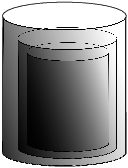
In this section, we'll consider another method for computing the volume of a solid of revolution. The idea is to break up the solid into cylindrical shells. The solid will be built up of an "infinite number" of cylinders, nested inside one another.

Suppose the region being revolved is bounded by a top curve and a
bottom curve, over some interval on the x-axis. Consider a small
piece of the region between the top and bottom curves and extending
horizontally from r to ![]() :
:
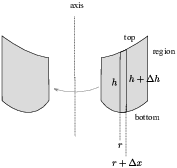
r is the distance from the axis of revolution to the edge of the small piece. It might not be the same as x if the axis of revolution is not the x-axis.
The height of the small piece varies from h to ![]() . Note that
. Note that ![]() could be positive, negative, or 0. For any
x-coordinate, this height is just the top curve minus the bottom
curve.
could be positive, negative, or 0. For any
x-coordinate, this height is just the top curve minus the bottom
curve.
As the small piece revolves about the axis of revolution, it sweeps out a solid which is approximately the region between two cylinders:
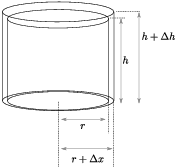
We can approximate the volume of this region as follows. The
cross-sectional area perpendicular to the axis of revolution is the
area between two circles of radii r and ![]() :
:
![]()
For the height, I'll use ![]() , the average value of h over the
interval.
, the average value of h over the
interval.
The volume of the solid swept out by the small piece is
![]()
If I sum the volumes of these solids and let the length of the
interval ![]() go to 0, I should get the
volume of the solid of revolution.
go to 0, I should get the
volume of the solid of revolution.
As ![]() , I can neglect the term
, I can neglect the term ![]() , since it is small compared to
the other term
, since it is small compared to
the other term ![]() . In addition,
. In addition,
![]() , where h is just the
difference between the top and bottom curves. So I have a sum of the
form
, where h is just the
difference between the top and bottom curves. So I have a sum of the
form
![]()
In the limit as ![]() , this
gives a Riemann sum for the integral
, this
gives a Riemann sum for the integral
![]()
If the axis of revolution is horizontal (parallel to the x-axis), the formula is
![]()
Example. The area under ![]() from
from ![]() to
to ![]() is revolved about the y-axis. Find the
volume generated.
is revolved about the y-axis. Find the
volume generated.
To do these problems I'll draw a cross-sectional picture. It shows the original region, and a copy of the region revolved to the other side of the axis. I'll draw a typical shell, showing the two places where the shell "goes through" the x-y-plane as vertical rectangles.
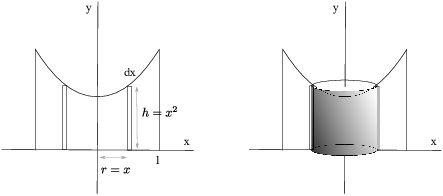
The first picture shows the cross-sectional picture. The second picture shows the cylinder drawn in the cross-section.
In the future, I'll just draw the cross-sectional picture.
The height of a typical cylindrical shell is ![]() . The radius of a typical
cylindrical shell is
. The radius of a typical
cylindrical shell is ![]() . The volume of the
solid is
. The volume of the
solid is
![]()
Example. The region bounded by ![]() and
and ![]() is revolved about the x-axis. Find the
volume of the solid generated.
is revolved about the x-axis. Find the
volume of the solid generated.
In this case, the shells go "sideways", parallel to the x-axis:
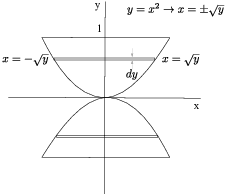
The height of a typical cylindrical shell is
![]()
The radius of a typical cylindrical shell is ![]() , the distance from the axis (the x-axis)
to the side of the shell. The volume of the solid is
, the distance from the axis (the x-axis)
to the side of the shell. The volume of the solid is
![]()
Example. The area under ![]() from
from ![]() to
to ![]() is revolved about the y-axis. Find the
volume of the solid generated using: (a) Circular washers, and (b)
Cylindrical shells.
is revolved about the y-axis. Find the
volume of the solid generated using: (a) Circular washers, and (b)
Cylindrical shells.
(a) Using washers, the inner radius of a typical washer is y and the outer radius of a typical washer is 1.
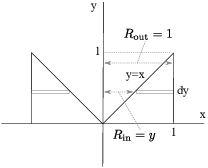
The volume of the solid is
![]()
(b) Using cylindrical shells, the height of a typical cylindrical
shell is ![]() and the radius of a typical
cylindrical shell is
and the radius of a typical
cylindrical shell is ![]() .
.
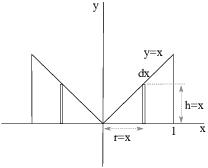
The volume of the solid is
![]()
Note that the thickness of a typical shell is ![]() , while the thickness of a typical washer
is
, while the thickness of a typical washer
is ![]() .
.![]()
Example. Let R be the region bounded by ![]() and
and ![]() , from
, from ![]() to
to ![]() .
.
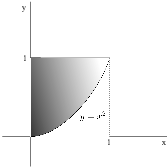
(a) Find the volume generated by revolving R about the line ![]() .
.
(b) Find the volume generated by revolving R about the line ![]() .
.
(c) Find the volume generated by revolving R about the line ![]() .
.
(d) Find the volume generated by revolving R about the line ![]() .
.
(a) The height of a typical cylindrical shell is ![]() . The radius of a typical
cylindrical shell is
. The radius of a typical
cylindrical shell is ![]() .
.
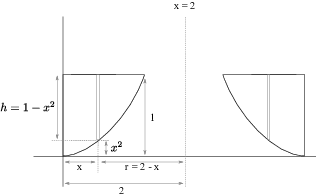
The radius is the distance from the axis to the side of a typical shell. In this case, I found it by subtraction.
Notice that I'm not trying to draw the cross-sectional picture to scale. Also, when I figure out r and h, I do my work on the original copy of the region, not the rotated copy. The rotated copy just gives me a sense of what the volume of revolution looks like.
The volume of the solid is
![]()
![]()
(b) The height of a typical cylindrical shell is ![]() . The radius of a typical
cylindrical shell is
. The radius of a typical
cylindrical shell is ![]() .
.
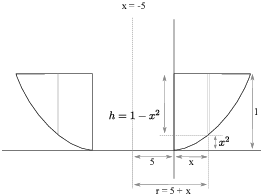
The radius is the distance from the axis to the side of a typical shell. In this case, I found it by addition. (Compare this to what I did in part (a).)
Once again, the picture is not drawn to scale.
The volume of the solid is
![]()
![]()
(c) If I solve ![]() for x, I get
for x, I get ![]() . I use the positive square root,
because I'm considering the part of the curve in the first quadrant
where x is positive.
. I use the positive square root,
because I'm considering the part of the curve in the first quadrant
where x is positive.
The height of a typical cylindrical shell is ![]() . The radius of a typical
cylindrical shell is
. The radius of a typical
cylindrical shell is ![]() .
.
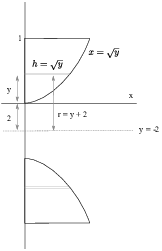
The volume of the solid is
![]()
You might try to set this problem up using circular washers.
(d) The height of a typical cylindrical shell is ![]() . The radius of a typical
cylindrical shell is
. The radius of a typical
cylindrical shell is ![]() .
.
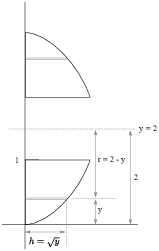
The volume of the solid is
![]()
Copyright 2019 by Bruce Ikenaga